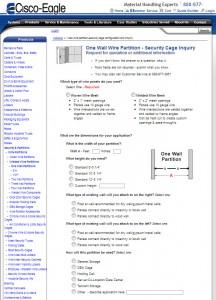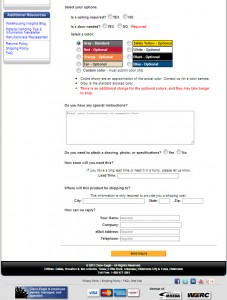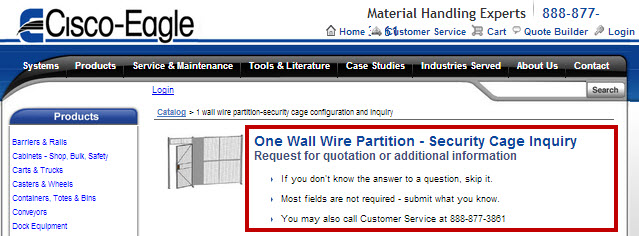Scott Stone, Advertising and E-Business Manager, Cisco-Eagle, submitted a form field page for live optimization on a recent Web clinic.
Unfortunately, we do not have time to optimize every submission live on Web clinics, and did not get to this submission.
So, we’ll offer some optimization suggestions in today’s MarketingExperiments blog post from Adam Lapp, Associate Director of Optimization and Strategy, MECLABS, to give Scott’s team specific suggestions while providing examples how these form field optimization principles can be applied in a real-life setting and hopefully spark some test ideas for your own forms.
Money isn’t the only cost
The page is an excellent example of one of the key principles featured in that Web clinic – “Do Optional Form Fields Help (or Hurt) Conversions?” – that explains cost doesn’t just exist where monetary transactions exist.
Any time you ask a prospect to give up something, there will be an associated cost.
So, before we get into Adam’s suggestions for addressing that cost, let’s take a look at the form field page Scott submitted.
Optimization suggestion #1: Don’t start a conversation with bullet points
Adam’s first suggestion introduces the importance of applying customer theory effectively.
“Quite frequently on the MarketingExperiments blog you will see recommendations for landing pages to use bullet points in order to make the content easier to read and scan. This is true. However, on this page the bullets are being fired off before the pistol’s hammer is even cocked.”
When I asked Adam for a little insight, he explained, “Part of the meta-theory behind offer-response optimization states that ‘people buy from people’ and this involves dialogue and a proper introduction.”
Adam further explained the impact offer-response has on conversion by using Burstein Automotive – a hypothetical car dealership owned by our Director of Editorial Content, Daniel Burstein.
Imagine you’re in Daniel’s car dealership and someone walks up to you holding a sign that reads:
- Good fuel mileage
- Leather seats
- Sun roof
“You’re probably not going to buy a car from them,” Adam declared. “How it happens in real life is a sales person introduces themselves and says, ‘Welcome to Burstein Automotive, How can I help you?’”
So before you fire the bullets, give some introduction copy telling customers they are in the right place and what they can expect to find.
“THEN, fire the bullets,” Adam said.
Optimization suggestion #2: Identify and express your value proposition
Adam’s next suggestion addresses the very heart of all marketing messages – value proposition.
 As Austin McCraw, Senior Editorial Analyst, MECLABS, teaches in our Value Proposition Development Online Course, for every offer you make to prospective customers, they weigh the value versus the cost before they decide to act on your offer.
As Austin McCraw, Senior Editorial Analyst, MECLABS, teaches in our Value Proposition Development Online Course, for every offer you make to prospective customers, they weigh the value versus the cost before they decide to act on your offer.
Adam’s concern with the landing page is it fails to answer a core question posed in the mind of a potential customer which is, “If I am your ideal prospect, why should I buy a wall wire partition from you rather than anyone else?”
“You are leaving a lot of deduction work on a prospective customer to figure out that this is the right place to buy a one wall wire partition,” Adam explained.
He added the value proposition being expressed should also be supported with evidentials.
“Once you briefly tell me why I should buy it from you, use the other real estate on the page to communicate the value of the product and its components,” Adam said.
Some examples of supporting information potential prospects want to know about the product are:
- How strong is the wire mesh?
- Can it be cut open easily?
- How many times have you tested the lock?
- Can it be picked?
- Is there a big difference between woven and welded?
- Is it weather resistant?
- Is it easy to install? Reuse? Uninstall?
Adam further described this landing page as a “cost center.”
“By that I mean, the ’perceived costs’ to potential prospects are time and information without giving them any ’perceived value’ in return that assures them that filling out the form is worth their invested effort,” Adam said.
Optimization suggestion #3: Identify and express value at every level in your sales process
 As I mentioned earlier; the primary question of value proposition is: “If I am [a particular prospect] why should I [take this action] rather than [this/these other action(s)]?”
As I mentioned earlier; the primary question of value proposition is: “If I am [a particular prospect] why should I [take this action] rather than [this/these other action(s)]?”
Often, organizations will only answer the primary value proposition and stop there.
The problem with this is the value proposition remains untested and will likely underperform – and that leaves some serious ROI on the table.
So, for those marketers wanting to capture that ROI left out on the table, communicating your value beyond a primary level is needed.
This will require everyone who works on your marketing campaigns to have a clear understanding of your value proposition – not just for your company as a whole, but for every action you desire a customer to take.
To help you do this, you need to think about how your value propositions translate throughout your sales process.
The value proposition spectrum is a tool you can use to help you to answer the primary value proposition question throughout your sales funnel:
1. Primary – “Why should your deal prospect buy from you rather than any of your competitors?”
2. Prospect – “Why should (Prospect A, B, or C) buy from you rather than any of your competitors?”
3. Product – “Why should (Prospect A, B or C) buy this product rather than any other product?
4. Process – “Why should (Prospect A, B or C) answer your call-to-action (click on a PPC ad for example) rather than any of your competitors?”
For Scott’s page, Adam identified a lack in value exchange at the process level.
“This page certainly lacks the fourth level which has to do with ‘why I should answer these questions and give you my name, email and telephone number,’” Adam said.
“Sure, the easy answer is to ‘get a quote,’ but that’s not good enough,” he added.
“Tell me what the quote will entail, how detailed it will be, how quickly it will be sent to me, what medium it will be sent to me in. Can I expect a call from a certified expert who will explain the product to me and answer any question I might have?” he continued.
When I asked Adam how user motivations affect his analysis, he explained that it’s important to understand which customer type you’re testing and optimization efforts are working to reach.
“I understand that for this industry, you probably have a lot of people who will come to this page and order no matter what. They are informed, they don’t need value, they know what to expect after they make an inquiry. We are not optimizing for this group of people, we are optimizing for the group of people who are on the metaphorical mesh wire fence.”
Related Resources:
Customer Value: The 4 essential levels of value propositions
Value Proposition: A free worksheet to help you win arguments in any meeting
Value Proposition Development: 5 insights to help you discover your value prop
Registration Forms: 3 steps to lead form optimization






